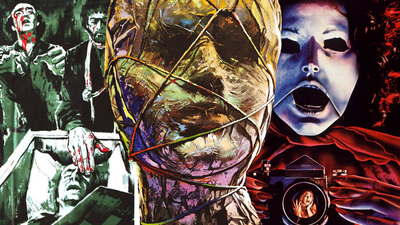
BY MATT BARONE |
The Best Slasher Movie in Years? Believe It or Not, It's a Video Game Written By Two Indie Filmmakers
Read on to find out how a pair of indie genre directors have bridged the gap between movies and games in a uniquely terrifying and bloody fashion.

The best slasher movies have something that’s much scarier than masked psychos hacking away with machetes: an underlying sense of helplessness.
The horror sub-genre’s strongest entries earn that recognition not only for their inventive kills and memorable killers but also for their characters. As is the case with any horror film, the fine line between watching with sadistic glee and emotional investment is drawn by how much the viewer actually gives a damn about the potential victims. The Texas Chain Saw Massacre's invalid Franklin (Paul A. Partain), for example, is so overly performed and unbearably whiny that it’s justifiable to beg for Leatherface to slice the insufferable chatterbox's portly belly open; Scream’s Tatum (Rose McGowan), on the other hand, is charming, lovable and a good friend to "final girl" Sydney Prescott (Neve Campbell), so watching her get turned into a human pretzel in that closing garage door hurts. And because of that fourth-wall-derived helplessness, there’s nothing the viewer can do to help her.
But what if slasher fans had the power to dictate who lives and who dies? In that empowered scenario, the cocky douche-bro who treats the sexy co-eds like pieces of meat could easily be eliminated, while the kindhearted virgin needn’t die—the viewer could simply make the douche-bro try to hide in an exposed closet rather than run through the wide-open doorway as the killer’s approaching him, and the virgin could do the opposite and see the end credits.
Thanks to modern technology, that kind of slasher movie is now a reality—it’s just not going to be seen in any movie theaters, and it requires a gaming console to be shown on a television screen. Released last week exclusively for Playstation 4, the new interactive horror video game Until Dawn has revolutionized the stalk-and-slaughter movie template popularized by genre icons like Jason Voorhees, Freddy Krueger and Michael Myers.
Created by Supermassive Games, Until Dawn is as authentic as any horror game can get, and that genuineness stems from Supermassive’s wise decision to hire a pair of experienced horror filmmakers to write the game’s mammoth script, which, all told, tallied at around 10,000 pages of dialogue. Starting the game’s production in 2011, Supermassive called upon two longtime collaborators who’d never worked in the gaming medium before: Glass Eye Pix founder Larry Fessenden, who's been a fixture in the independent horror scene and New York City’s patron saint of DIY scares since the late '90s, and Fessenden’s go-to sound designer Graham Reznick, who’s also a writer-director in his own right. (See: the 2008 indie feature I Can See You.)

The game’s set-up is vintage '80s slasher construction: eight young and attractive friends head into a mountainside lodge for a party-filled weekend when they’re suddenly trapped inside its claustrophobic walls as a deranged, mask-wearing madman hunts them down. It's nighttime, the weather outside is frightful and the damaged electricity makes flashlights and candles a navigation priority. The kids themselves, rendered by putting real actors through facial-capture tech, are also familiar slasher conventions: there’s the beautiful and easily likable Samantha (played by Nashville's Hayden Panettiere); the arrogant douche-bro Mike (Marvel's Agents of S.H.I.E.L.D. co-star Brett Dalton); the party’s fun-loving organizer, Josh (Mr. Robot star Rami Malek); and the somewhat cold-hearted Emily (Nichole Bloom), who’s the antithesis of Panettierre’s Sam.
With its human-looking characters and overall cinematic veneer, Until Dawn is the closest gamers have come yet to living inside an actual horror movie. Split into ten "chapters," the game allows players to oversee each of the eight youngsters at various times and unfolds a lot like those old Choose Your Own Adventure books. Their actions, whether they’re merely exploring or sprinting at full-speed away from the killer, are interrupted by two next-move options, and it’s up to the player to pick which move to make. In some cases, it’s either "Run" or "Hide"; in others, it’s a choice between fighting back or continue being the hunted.

For co-writer Reznick, Until Dawn was a dream come true that, as a filmmaker, the now-34-year-old storyteller never expected to see happen. He grew up in Delaware as a video game fanatic, gravitating more towards PC games, like those released by Sierra Entertainment, than consoles like Nintendo or Sega. When he wasn’t playing Sierra titles, Reznick was hanging out with his friend, and fellow soon-to-be filmmaker, Ti West, who's currently one of independent horror’s most acclaimed directors. They’ve remained tight all throughout their careers so far, with Reznick handling the sound in all of West’s movies. He’s been an especially key player in West’s most successful films: the Satanic-Panic-minded ’80s throwback The House of the Devil (2009), the blue-collar horror-comedy The Innkeepers (2011) and last year’s Jonestown-inspired cult thriller The Sacrament.
The childhood pals followed each other to Manhattan for college; Reznick attended New York University's Tisch School of the Arts, while West went to the School of Visual Arts. The SVA is where West’s relationship with teacher/filmmaker Kelly Reichardt led to him meeting Fessenden, with whom Reichardt was good friends. At the time, Fessenden was all the city’s rage as a result of his critically lauded 1997 film Habit, a clever vampire subversion that appealed to West’s horror-loving sensibilities. Around 2000, West’s newfound friendship with Fessenden led to Reznick befriending the Glass Eye Pix maestro, and the three of them have worked together ever since; all of West’s films minus The Sacrament have been Glass Eye Pix productions. So when Supermassive asked Fessenden to help them flesh out an ambitious new horror title in 2011, Fessenden utilized his younger buddy Reznick’s video game fandom and brought him on as a co-writer.
The Glass Eye Pix duo’s assignment was to bring their filmmaking inclinations and horror expertise to Supermassive’s already-established—internally within the company, at least—Until Dawn universe. Fessenden and Reznick were given the “kids trapped inside a lodge” foundation and then left to develop the characters into believable protagonists and ensure that Until Dawn’s scare tactics and genre beats wouldn’t leave horror fans crying foul. "Until Dawn gives you a very stereotypical approach and very stereotypical characters and has them do the things you’re familiar with, but then it puts you in control," says Reznick. "Our players are given a certain amount of control over the characters, which allows you to take a stereotypical character and mold them into something that’s more reflective of you, the person who’s playing. That immediately raises the stakes and makes things scarier, because you’re truly invested in the characters. With each move and decision they make, the game’s characters start to resemble aspects of the player’s own personality."

There's been a genre-specific uphill battle throughout Until Dawn’s conception, though: slasher movies aren’t just out of vogue these days—they’ve become formulaic and, even worse, the opposite of scary. In 1996, Wes Craven and screenwriter Kevin Williamson’s intelligently self-aware Scream laid all of the slasher format’s rules out, laughed at them and then diced them up with Ghostface’s knife, and slasher cinema has never been able to get his ’80s-era, pee-your-pants groove back.
Whereas other filmmakers might have let that reality hinder them, Fessenden and Reznick welcomed the challenge, mainly because video games with Until Dawn’s staggering advancements are completely uncharted terrain for guys like Jason, Freddy and Michael. (The less said about the amazingly bad NES Friday the 13th game here, or anywhere, the better.) "One of the great things about slasher movies is that they involve the audience in ways that’s very unique," says Reznick. "It’s almost like watching sports, in a weird way. You’re rooting for people or rooting against people in ways that you don’t in other types of films. What Larry and I were so attracted to with Until Dawn was that it presented an opportunity to, if not reinvent, reinvigorate some of the life that’s been lost to the slasher conventions. It’s not super meta—it’s not Scream or The Cabin in the Woods or something that addresses the slasher genre in a snarky way. You won’t play it and think the makers of saying to you, 'Yeah, slasher movies are stupid! And isn’t it so dumb how they do the same things in each one! And here are their rules!'"
Initially planned as a Playstation 3 game, Until Dawn was upgraded to the PS4 once the PS3’s capabilities became dated. The systematic upgrade was both a screenwriter’s best-case outcome and a nightmare for anyone who enjoys sleep. The PS4 enhancement meant that Fessenden and Reznick had to rewrite all of the characters’ dialogue and reconfigure their back-stories and in-game arcs accordingly. But that also allowed Until Dawn to skew closer to what they know best: a traditional movie. "The original version was all first-person, so it wasn’t as cinematic," says Reznick. "A lot of the original dialogue was really on-the-nose and jokey, with characters off-screen telling you everything that’s going on. Because of the PS3 technological limitations, you couldn’t tell a story the way you tell a story in a movie, but with the PS4 version. But because of the incredibly hi-def facial capture technology that’s now available for the PS4, Supermassive realized they could get actors to come in and actually be actors, and do what they do in a film. That’s when we were able to start writing Until Dawn like a real movie script."
The major difference being, though, that what normally requires one or two pages in a movie screenplay demanded upwards of seven or eight pages of material within Until Dawn’s multi-character gaming world. By saving a character in the third chapter, for example, the player sets a chain of events into motion that wouldn’t happen if he or she were to cause that same character’s death, and that "Butterfly Effect" of sorts is applicable to every single character. "It became this complex, bizarre, almost Rube Goldberg-esque system where we had to remember where all the characters were according to the story’s parallel scenarios, and to keep track of how little things that happen in Chapter 2 could change what happens in Chapter 8," says Reznick. "In the game, if a character dies, he or she is dead—the player can’t go back and fix their mistakes, so that affects the player’s decisions in a major way and dictates how the rest of that specific player’s game will turn out. Based on what you do in previous chapters, a scene in, say, Chapter 7 can have Mike, Chris and Sam, or it could have Emily, Sam and Josh."
The ways in which Until Dawn merges Hollywood with the gaming world aren’t new. Games like 2011’s L.A. Noire and 2013’s Beyond: Two Souls similarly blended actors’ performances with motion-capture to create impressively realistic visuals, and the Playstation-and-Xbox-compatible Life is Strange, released earlier this year, also features an interactive "Butterfly Effect" storyline that’s broken into sections. But Until Dawn is the most accessible of the bunch. Life is Strange, for instance, is an abstract time-travel adventure that’d be more at home in the Tribeca Film Festival’s Midnight lineup than in a Loews multiplex on a Friday night; Until Dawn, however, is a quintessential grab-some-popcorn-and-have-a-blast Hollywood horror rollercoaster. And if the game is financially triumphant, it could signal a major gaming shift towards more Hollywood-friendly subject matter with interactive gameplay. "In the way that we tend to think of them, video games are essentially now 30 years old,” says Reznick. "I think we’re all ready for more games to embrace these kinds of narratives."
He adds, "There’s a traditional way of looking at things that sees movies in one slot, video games in another slot, TV in a third slot and then prose in fourth slot, but it’s all just one big spectrum. That spectrum is very blurry, and there’s no reason why it shouldn’t be. All of those mediums should be able to coexist. I’m currently working on various VR projects on the side, but that’s not the only thing I want to do—sometimes I want to just sit down and watch nine straight hours of a show on Netflix. But I wouldn’t necessarily want to do that with a VR headset. There are different applications for different mediums, and it’s really great that we have so many things available to us now to help use these mediums together in different ways to tell stories."
Now officially a member of the professional gaming community, Reznick has immersed himself within that previously foreign space. And through that, he’s encountered some resistance to Until Dawn’s unique presentation. Not everyone’s happy with how it connects movie-going with controller-based gaming.
But Reznick hopes they’ll eventually think bigger. "There’s a lot of debate within the hardcore gamer set about whether or not Until Dawn is actually a video game," he says. "People say, 'Oh, it’s not really a game—you’re just watching a movie and making some choices.' And my response to that is, 'Why does it matter?’ It shouldn’t matter whether you call it a 'game' or 'interactive fiction.' I don’t think having boundaries is a helpful way of looking at art. Most, if not all, gamers think video games are art, right? So why not try to create that art in any way that you can?"

